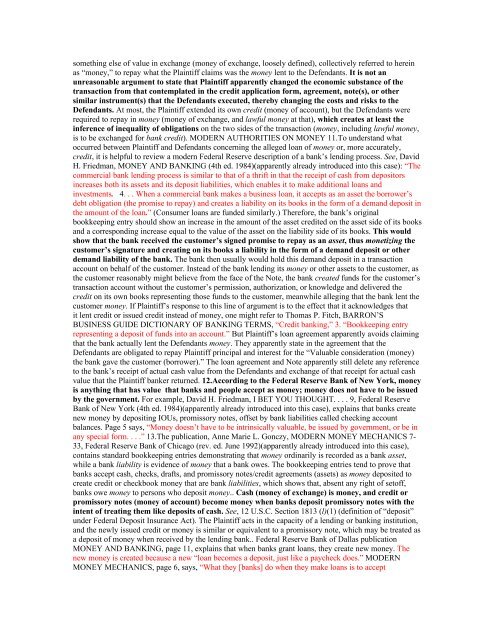Mortgage-KillerEX
Mortgage-KillerEX
Mortgage-KillerEX
You also want an ePaper? Increase the reach of your titles
YUMPU automatically turns print PDFs into web optimized ePapers that Google loves.
something else of value in exchange (money of exchange, loosely defined), collectively referred to herein<br />
as “money,” to repay what the Plaintiff claims was the money lent to the Defendants. It is not an<br />
unreasonable argument to state that Plaintiff apparently changed the economic substance of the<br />
transaction from that contemplated in the credit application form, agreement, note(s), or other<br />
similar instrument(s) that the Defendants executed, thereby changing the costs and risks to the<br />
Defendants. At most, the Plaintiff extended its own credit (money of account), but the Defendants were<br />
required to repay in money (money of exchange, and lawful money at that), which creates at least the<br />
inference of inequality of obligations on the two sides of the transaction (money, including lawful money,<br />
is to be exchanged for bank credit). MODERN AUTHORITIES ON MONEY 11.To understand what<br />
occurred between Plaintiff and Defendants concerning the alleged loan of money or, more accurately,<br />
credit, it is helpful to review a modern Federal Reserve description of a bank’s lending process. See, David<br />
H. Friedman, MONEY AND BANKING (4th ed. 1984)(apparently already introduced into this case): “The<br />
commercial bank lending process is similar to that of a thrift in that the receipt of cash from depositors<br />
increases both its assets and its deposit liabilities, which enables it to make additional loans and<br />
investments. 4. . . When a commercial bank makes a business loan, it accepts as an asset the borrower’s<br />
debt obligation (the promise to repay) and creates a liability on its books in the form of a demand deposit in<br />
the amount of the loan.” (Consumer loans are funded similarly.) Therefore, the bank’s original<br />
bookkeeping entry should show an increase in the amount of the asset credited on the asset side of its books<br />
and a corresponding increase equal to the value of the asset on the liability side of its books. This would<br />
show that the bank received the customer’s signed promise to repay as an asset, thus monetizing the<br />
customer’s signature and creating on its books a liability in the form of a demand deposit or other<br />
demand liability of the bank. The bank then usually would hold this demand deposit in a transaction<br />
account on behalf of the customer. Instead of the bank lending its money or other assets to the customer, as<br />
the customer reasonably might believe from the face of the Note, the bank created funds for the customer’s<br />
transaction account without the customer’s permission, authorization, or knowledge and delivered the<br />
credit on its own books representing those funds to the customer, meanwhile alleging that the bank lent the<br />
customer money. If Plaintiff’s response to this line of argument is to the effect that it acknowledges that<br />
it lent credit or issued credit instead of money, one might refer to Thomas P. Fitch, BARRON’S<br />
BUSINESS GUIDE DICTIONARY OF BANKING TERMS, “Credit banking,” 3. “Bookkeeping entry<br />
representing a deposit of funds into an account.” But Plaintiff’s loan agreement apparently avoids claiming<br />
that the bank actually lent the Defendants money. They apparently state in the agreement that the<br />
Defendants are obligated to repay Plaintiff principal and interest for the “Valuable consideration (money)<br />
the bank gave the customer (borrower).” The loan agreement and Note apparently still delete any reference<br />
to the bank’s receipt of actual cash value from the Defendants and exchange of that receipt for actual cash<br />
value that the Plaintiff banker returned. 12.According to the Federal Reserve Bank of New York, money<br />
is anything that has value that banks and people accept as money; money does not have to be issued<br />
by the government. For example, David H. Friedman, I BET YOU THOUGHT. . . . 9, Federal Reserve<br />
Bank of New York (4th ed. 1984)(apparently already introduced into this case), explains that banks create<br />
new money by depositing IOUs, promissory notes, offset by bank liabilities called checking account<br />
balances. Page 5 says, “Money doesn’t have to be intrinsically valuable, be issued by government, or be in<br />
any special form. . . .” 13.The publication, Anne Marie L. Gonczy, MODERN MONEY MECHANICS 7-<br />
33, Federal Reserve Bank of Chicago (rev. ed. June 1992)(apparently already introduced into this case),<br />
contains standard bookkeeping entries demonstrating that money ordinarily is recorded as a bank asset,<br />
while a bank liability is evidence of money that a bank owes. The bookkeeping entries tend to prove that<br />
banks accept cash, checks, drafts, and promissory notes/credit agreements (assets) as money deposited to<br />
create credit or checkbook money that are bank liabilities, which shows that, absent any right of setoff,<br />
banks owe money to persons who deposit money.. Cash (money of exchange) is money, and credit or<br />
promissory notes (money of account) become money when banks deposit promissory notes with the<br />
intent of treating them like deposits of cash. See, 12 U.S.C. Section 1813 (l)(1) (definition of “deposit”<br />
under Federal Deposit Insurance Act). The Plaintiff acts in the capacity of a lending or banking institution,<br />
and the newly issued credit or money is similar or equivalent to a promissory note, which may be treated as<br />
a deposit of money when received by the lending bank.. Federal Reserve Bank of Dallas publication<br />
MONEY AND BANKING, page 11, explains that when banks grant loans, they create new money. The<br />
new money is created because a new “loan becomes a deposit, just like a paycheck does.” MODERN<br />
MONEY MECHANICS, page 6, says, “What they [banks] do when they make loans is to accept












![[Pham_Sherisse]_Frommer's_Southeast_Asia(Book4You)](https://img.yumpu.com/38206466/1/166x260/pham-sherisse-frommers-southeast-asiabook4you.jpg?quality=85)




